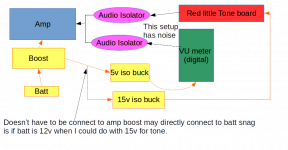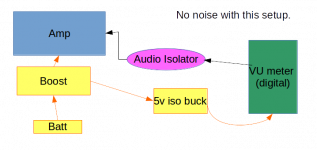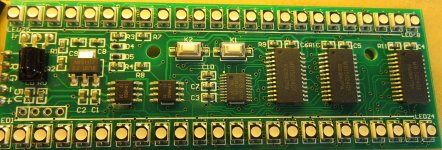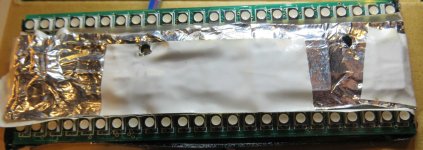Same units without the case. You can get complete units cheaper and take the case off. That's what I do..
in that case, with the case it is 🙂
that's a surprise, looks like the transformer is bigger in the photo? they don’t say the audiophile version comes without case.
Pls see above picture. Our HIFI version use bigger permalloy core in transformer. The low frequency can reach 20HZ. You absolutely couldn’t hear distortion in low frequency. This isolator even can drive headphone.
The mains ground connection may (or may not) be carried through to the DC ground (as you call it). This is a pure design choice and depends on the individual equipment in question. There is no safety hazard or electrocution risk. Many commercial amplifiers and source components do indeed have direct continuity by design from mains ground to both chassis and the audio ground.
Mains ground is at zero potential relative to the floor you stand on, the walls you touch and so on.
Yea, Wasn’t too sure about dc - mains ground stuff, didn’t know.... so im grateful to your efforts to educate me 🙂
cus you can still get ground loops with mains gear? had/having trouble with my diy computer surround sound setup, but thats for another thread though.
This is the unit I have used and will vouch for. Very good results! No loss in bass/treble. I'm impressed!
KROAK Car Auto 3.5mm Aux Audio Noise Filter Ground Loop Isolator Eliminate Car Electrical Noise-in Bluetooth Car Kit from Automobiles & Motorcycles on Aliexpress.com | Alibaba Group
Every unit I build operates from battery. Derived from a 12 volt source @ 12, 5, or whatever I need. I was always plagued with loop problems and junk transformer type isolation. The above units are good..
KROAK Car Auto 3.5mm Aux Audio Noise Filter Ground Loop Isolator Eliminate Car Electrical Noise-in Bluetooth Car Kit from Automobiles & Motorcycles on Aliexpress.com | Alibaba Group
Every unit I build operates from battery. Derived from a 12 volt source @ 12, 5, or whatever I need. I was always plagued with loop problems and junk transformer type isolation. The above units are good..
hmm so got a much of dc-dc isolated converters and better audio isolators.
snag is with the VU meter i still got noise. im coming to the conclusion that maybe the VU meters micro processor is emitting noise/emi that is being picked up by audio stuff, pre amp.
so i guess i need to shield the vu meter, use really short wires and i guess thread the wires going into the vu meter though a emi ring filter thing (i forget the name...)?
unless maybe this vu meter damaged??? i guess i have to see if same problem with other vu meter.
with the duel +/- dc convter i got for fancy large tone board preamp. i have really bad noise. its a fancy meanwell high current one because of concerns about getting inrush current limiters ntc wrong and frying yet another dc-dc converter from too high capacity load. its rated for 1000uf cap load which is same as the large blue caps on the tone board.
hmm maybe try bigger isolated dc converter which higher cap load limit
Electronic Components and Parts Search | DigiKey Electronics
or one with lower ripple like TMR 3-2423WIR | TRACOPOWER TMR 3WI 3W Isolated DC-DC Converter Through Hole, Vin 9 → 36 V dc, Vout +-15V dc | TRACOPOWER
???
arr hmm hmm :/
snag is with the VU meter i still got noise. im coming to the conclusion that maybe the VU meters micro processor is emitting noise/emi that is being picked up by audio stuff, pre amp.
so i guess i need to shield the vu meter, use really short wires and i guess thread the wires going into the vu meter though a emi ring filter thing (i forget the name...)?
unless maybe this vu meter damaged??? i guess i have to see if same problem with other vu meter.
with the duel +/- dc convter i got for fancy large tone board preamp. i have really bad noise. its a fancy meanwell high current one because of concerns about getting inrush current limiters ntc wrong and frying yet another dc-dc converter from too high capacity load. its rated for 1000uf cap load which is same as the large blue caps on the tone board.
hmm maybe try bigger isolated dc converter which higher cap load limit
Electronic Components and Parts Search | DigiKey Electronics
or one with lower ripple like TMR 3-2423WIR | TRACOPOWER TMR 3WI 3W Isolated DC-DC Converter Through Hole, Vin 9 → 36 V dc, Vout +-15V dc | TRACOPOWER
???
arr hmm hmm :/
this is the meanwell dc converter im using for the fancy large tone board DKMW30G-15 Mean Well USA Inc. | Power Supplies - Board Mount | DigiKey
Why is the output of the VU meter and the output of the tone board in parallel? Shouldn't the VU meter be in series between the tone board output and the input of the amp to monitor the input to the amp? Audio isolation will be needed on the in/out of the VU meter, being it's on an island of its own power supply.
Last edited:
Its a digital rgb led vu meter. so parallel is the only option.
its using a isolated power supply from digikey.
I have used 2 audio isolators also. one for vu meter, and tone board out to amp/vu. I’ve tried various combinations for the audio isolators.
its using a isolated power supply from digikey.
I have used 2 audio isolators also. one for vu meter, and tone board out to amp/vu. I’ve tried various combinations for the audio isolators.
If the input to the VU meter isn't isolated, it defeats the reason for the isolated 5 volt supply. The input audio shielding for the tone board and the VU input connects them together, hence causing a loop between the 5 volt isolated supply and the 15 volt supply for the tone board.
3 isolators. One before/after the VU meter and one before the input of the amp. (assuming the audio source is powered separately from everything else)
3 isolators. One before/after the VU meter and one before the input of the amp. (assuming the audio source is powered separately from everything else)
Last edited:
Even without the tone board (which btw is the smaller single dc red little board.). Just the vu meter on its own , i get this annoying noise. with a audio isolator it think it was not so bad... or maybe ok, arr i need to test it again, i cant remember well enough. i think i may also need a extra pre amp for the vu meter input when using audio isolator because of its not so sensitive
The little red tone board is fine on its own, very little noise.
Re: the large fancy, black pcb, duel 15v dc tone board i was testing on its own with different speakers/amp which where mains powered. power the tone board via bench power supply and earth gnd disconnected from DC gnd on the bench power supply. As mine came with optional connection terminal thingy. So its not a ground loop but just in case i used a audio isolator too. The noise is from this meanwell dc-dc converter :|
The little red tone board is fine on its own, very little noise.
Re: the large fancy, black pcb, duel 15v dc tone board i was testing on its own with different speakers/amp which where mains powered. power the tone board via bench power supply and earth gnd disconnected from DC gnd on the bench power supply. As mine came with optional connection terminal thingy. So its not a ground loop but just in case i used a audio isolator too. The noise is from this meanwell dc-dc converter :|
I’ve made some new diagrams to show the different wiring/setups.
The .odg files in a zip, are the source files in standard Open Document drawing format. Made using libreoffice.
The .odg files in a zip, are the source files in standard Open Document drawing format. Made using libreoffice.
Attachments
Tried shielding a led VU meter with aluminium tape with electrical tape underneath for anti short protection. Connected to its power supply gnd.
It helped to reduced the high pitch whine but there still was a lot of noise. While i fiddling about it sounded like a cpu/microprocessor noise.
hmm at this rate i might end up giving on the led vu meter, which would be a shame as it really nice to have and quite helpful.
It helped to reduced the high pitch whine but there still was a lot of noise. While i fiddling about it sounded like a cpu/microprocessor noise.
hmm at this rate i might end up giving on the led vu meter, which would be a shame as it really nice to have and quite helpful.
i didn’t have isolators before. after blowing up power supplys ive been using them. Im getting tech help now with a scope. we are progressing... 🙂
this was the best positive negative dual rail dc-dc converter i found for powering dual rail tone board preamp
HIFI Class Low Noise Low Internal Resistance Single Voltage to Positive and Negative Power Outputs Regulated Power Supplies-in Operational Amplifier Chips from Consumer Electronics on Aliexpress.com | Alibaba Group
Note the 1000uf caps on the fancy tone board will destroy the board due to exceeding its capacitative load limit. So i removed the 1000uf power supply smoothing caps that where designed for when it was powered from a transformer. didn’t need them in my case, i think.
still had problems powering the dc-dc converter as its a boost board with max input voltage near 5v. so i needed another buck converter to give it 5v but that added noise/gnd loop. not solved that problem 🙁
been sitting on shelf since. would be nice to fix it...
HIFI Class Low Noise Low Internal Resistance Single Voltage to Positive and Negative Power Outputs Regulated Power Supplies-in Operational Amplifier Chips from Consumer Electronics on Aliexpress.com | Alibaba Group
Note the 1000uf caps on the fancy tone board will destroy the board due to exceeding its capacitative load limit. So i removed the 1000uf power supply smoothing caps that where designed for when it was powered from a transformer. didn’t need them in my case, i think.
still had problems powering the dc-dc converter as its a boost board with max input voltage near 5v. so i needed another buck converter to give it 5v but that added noise/gnd loop. not solved that problem 🙁
been sitting on shelf since. would be nice to fix it...
Last edited:
Do you have details on the VU meter assembly (such as photos, schematic) - it may be worth assessing if its inherent noise can be suppressed, as that may reduce noise getting in to the rest of the system.
thergb led vu meter and pictures
RGB MCU Display Pattern Dual Channel 24 LED VU Level Indicator Meter F Amplifier 699939172751 | eBay
RGB MCU Display Pattern Dual Channel 24 LED VU Level Indicator Meter F Amplifier 699939172751 | eBay
Attachments
I can see the +/- 5V input supply traces, but not sure what traces are used to bring the audio signal in. Can you confirm if the -5V terminal is also used for the audio signal input of the VU meter?
Can you make a battery powered +5V supply to power that VU pcb? Eg a small 12V battery through a 7805 regulator. That would assist identifying what noise is coming from the VU pcb by way of the audio signal lines only.
Can you make a battery powered +5V supply to power that VU pcb? Eg a small 12V battery through a 7805 regulator. That would assist identifying what noise is coming from the VU pcb by way of the audio signal lines only.
thanks for the reply. its not duel rail but single rail. confusing i know... 5v +, 5v - is pwr gnd, audio gnd, right, left.
not sure is audio gnd is separate from pwr gnd. ill check later.
not sure is audio gnd is separate from pwr gnd. ill check later.
Last edited:
cant remember... might have tried a separate power source like that... i forget now... it likely I did try. hmm i think the noise was better or with with a separate isolated power supply, like a anker usb power bank
The 5V rail bypass cap impedance may not be low enough to avoid pulsed currents being drawn from the 5V supply - so it may be worth temporarily soldering a small electrolytic across the 5V terminal pads - eg. something like 25uF 16V or whatever you have that is small and pcb mount.
You may have to work out the traces of the power supply and signal grounds by inspection of the pcb, and an ohmeter to confirm.
You may have to work out the traces of the power supply and signal grounds by inspection of the pcb, and an ohmeter to confirm.
- Status
- Not open for further replies.
- Home
- Amplifiers
- Power Supplies
- Battery Powered DC-DC Converters For Modules & Audio Noise Problem. Help?





